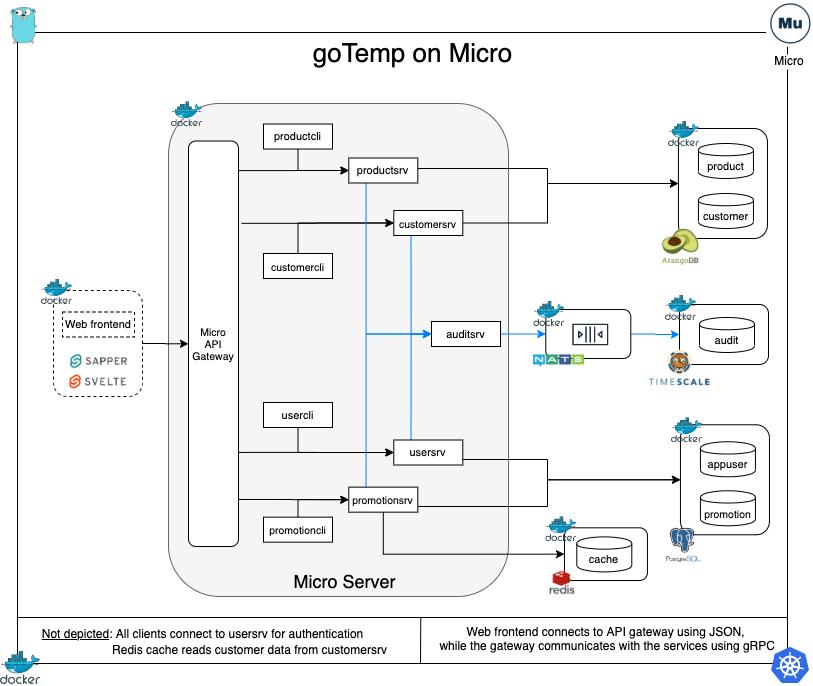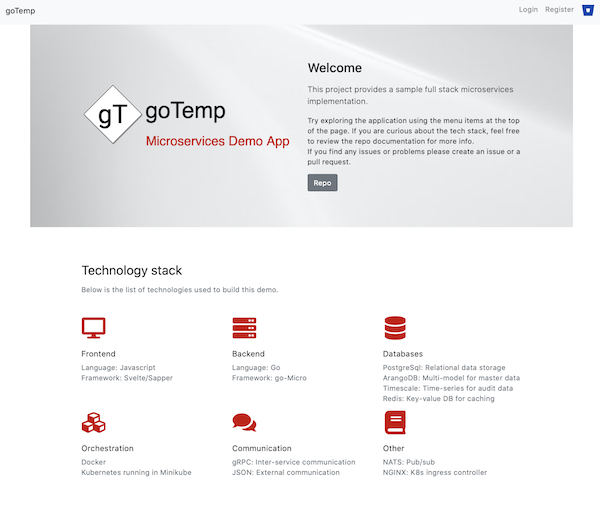goTempM is a full stack Golang microservices sample application built on top of the Micro platform. Note that the original goTemp, which is built directly on the go-Micro framework, is still available and can be found in the goTemp repo. It is worth noting that Micro itself uses go-Micro as its underlying framework.
In it current incarnation (this is wip), this mono-repo uses the following stack as backend:
Golangas its main implementation technologyMicroas the microservices platform running our servicesgRPCfor inter-service real time communicationNATSfor Pub/Sub event driven communicationmulticast DNSfor service registration and discoveryPostgreSqlfor transactional data storageTimescaleDBtime series DB used for historical audit data storageArangoDBis a multi-model database used for master data storageRedisis used to cache data and reduce number of data requests to other servicesDockerfor creating application imagesDocker-composeto run the applicationMinikubeto run the application in Kubernetes
In terms of the web front end, the stack is as follows:
Javascriptas its main implementation technologySvelteis used as the compilation engine (via rollup)Sapperis the javascript frameworkSveltestrapprovides the css framework and is based on bootstrapFont Awesometo display icons in the application
Below is a diagram that displays the overall setup of the application:
In a nutshell. the application functionality is as follows in the backend:
- The frontend connects to the different services through the Micro API gateway
- For each service the frontend provides:
- Search page
- Detail page
- Additionally, the frontend provides:
- Landing page
- Login page
- Register page
- Each service performs the basic CRUD operations to their underlying databases
- All services authenticate via the user service
- All completed CUD operations are forwarded to the NATS broker which in turn forwards the message to the auditing service. This service saves the data into TimescaleDB.
- Each service has a client which can be used to test all basic CRUD functionality
Before running the application the first time:
- Clone the repository
- cd into
gotempM/web/sapper - Run the following command to generate the javascript dependencies.
npm installTo start the application:
- Ensure that Docker is installed and running. Then, execute the following command from a terminal in the goTempM root folder:
make microupDepending on whether you have run the application before, docker may have to download all the dependent images (Micro, PostgreSql, TimescaleDB, Nodejs, etc). This may take a while depending on your internet connection speed. Once everything has been downloaded and started, you should see a message in the terminal indicating that the application is listening at localhost:3000. At that point, yo can open your browser and navigate to:
http://localhost:3000
Ensure that Minikube is installed and running.
The project is organized in a way that each folder represents either a service, a database or a shared library package. Currently, we have the following:
arangodb: Volumes mounted to the ArangoDB container as well as data initialization scriptsaudit: Audit service to collect and store historical audit informationcicd: Holds files related to CI/CD and orchestrationcustomer: Customer master data servicediagramforDocs: Diagrams used in the readme documentsglobalCache: Enables Micro to use Redis as a cache store which can then be used in our servicesglobalErrors: Generic errors shared packageglobalProtos: Generic protobuf message definitions shared across packagesglobalUtils: Generic utilities shared packagemicro: Hosts the custom Dockerfile that is used to run Micro.nats: NATS dockerfile and configurationpostgres: Volumes mounted to the PostgreSQL DB container as well as data initialization scriptsproduct: Product master data servicepromotion: Promotion service to track product discounts (this was the first service built)redis: Volumes mounted on the redis container as well as config files (if any)timescaleDB: Volumes mounted to the Timescale DB container as well as data initialization scriptsuser: User and authentication serviceweb: application web frontend
Additionally, we have the following files in the root directory as well:
.dockerignore: Files to be ignored when building service images.gitignore: Files to be ignored by gitdocker-compose: File controls the building of the different services and their dependenciesdocker-compose-test: Override compose file that can be used to test different services with their dependenciesgo.mod and go.sum: Go modules controlmain.go: Not used for services yetMakefile: shortcuts to common actionsReadme.md: Well... this file...
We use Micro as the main GO microservices platform. Using Micro simplifies many of the tasks associated with building
microservices including (but not limited to):
- Service discovery
- gRPC for inter service communication
- Built in async messaging (in our case used to set up pub/sub messages to NATS )
- Built-in data storage interface (in our case used to interact with Redis)
- API gateway:
- Request routing
- Load balancing
- Automatic conversion of frontend JSON payloads to backend gRPC messages
Each one of the services has a similar structure:
client: Contains a client service that calls the server service to perform multiple operationsproto: Proto buffer messages and services definitions. Empty if service does not handle real time inter-service communication.server: Service that performs a number of actions like interacting with the DBDockerfile: Build the image for the server serviceDockerfileCLI: Build the image of the client servicedocker-compose.env: Environment variable required to run the service when running the service with docker-composedocker-compose-cli.env: Environment variable required to run the client when running the client with docker-compose
The services must be started using Micro run. Since we are using the Dockerized version of Micro, we can start a service as follows:
If Micro is not already running:
make microserveup
This will start Micro as well as all the DBs used by goTempM. Get into the Micro container, if not in it already:
docker exec -it microservercont bash
Start the service:
make micro<serviceName>
where can be usersrv, auditsrv, customersrv, productsrv or promotionsrv.
Note: all the commands below must be run within the Micro container
To run some data through a service once it is started, we can run the service client:
micro run --name <serviceClientName> <serviceFolder>/client
where can be usercli, auditcli, customercli, productcli or promotioncli. For example, we could start the user client as follows:
micro run --name usercli user/client
This will bring up run the client service which will attempt to create,update and delete a user. The results will be printed to the log. To see the logs, run:
micro logs -f <serviceOrClientName>
The server user service will update the DB as necessary and send the updated information to the broker (NATS) so that the audit service may eventually store it in the time series DB. The audit service can be started using:
make microauditsrv
The project initializes each of the DBs and seeds them with tables and data. Data changes made at run time are automatically persisted using mounted volumes when running via docker-compose. See the folders for each DB for details as well as the docker-compose file.
Our web front end is built with Svelte and Sapper which have some interesting benefits:
- Server-side initial rendering of our pages
- File based routing
- Smaller code base than other Javascript frameworks. Does more with less.
- Svelte translates the code to vanilla javascript. Thus, smaller application footprint than most frameworks
- Emphasis on component re-usability
The web application lives in the ./web folder. Since Sapper and Svelte generate multiple files and folders, we will just discuss the relevant folders below:
sapper: The main folder containing the web appsrc: This is where the bulk of the application residescomponents: Contains re-usableSveltecomponentsglobalUtils: Shared javascript utilitiesroutes: application routes to the different pagesclient.js: This is a required file. It is used to startSapper.server.js: Used to configure the app with items like middleware and compressiontemplate.html: Main page that contains our application. We added Bootstrap and Font Awesome CDN references in this page.
static: Holds static items
Dockerfile: Used to build the docker image for the web app
All of our main routes are pretty standard in terms of organization. We will use the customer route (./web/sapper/src/routes/customer) as an example:
index.svelte: Main customers search page that serves at localhost:3000/customer_searchGridSlot: Component holds the template for the search grid to be display in hte search page (index.svelte)new.svelte: Page to be displayed when user want to create a new customer. Displayed at localhost:3000/customer/new .[slug].svelte: Page to view and modify existing customers. Displayed at localhost:3000/customer/[customerid]_detail.svelte: Holds the gui and bulk of the logic for adding or editing customers. It is called by new.svelte and [slug].svelte .
There are three routes that do not share the structure above as they have very little functionality and thus are server by a single index.svelte component: root, register and login.
Additional information can be found in the individual folders either in a readme.md or a doc.go file.
Additionally, the Makefile contains many command samples that can be used for development.

